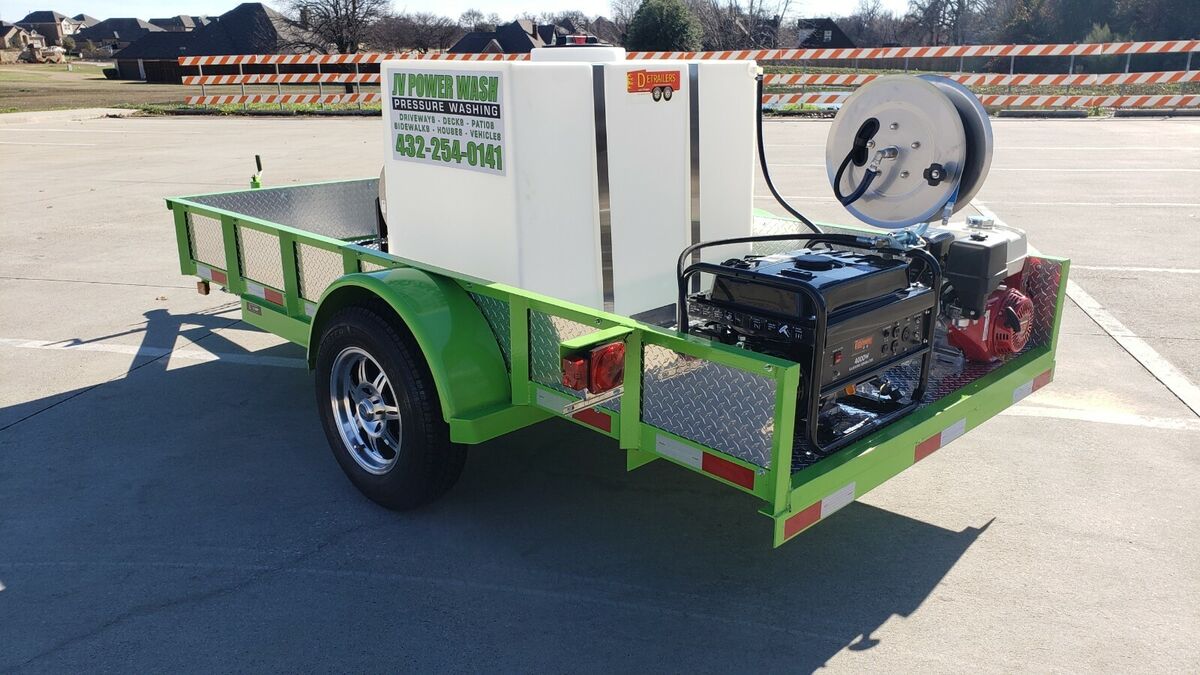
If you’re ready to take your pressure washing hustle to the next level, there’s one essential upgrade you’ll need: a mobile power washing rig. Whether you’re cleaning driveways, fleet vehicles, or storefronts, a mobile setup gives you the freedom to take your services anywhere — efficiently and professionally. 🧼💨
In this guide, we’ll walk you through everything you need to build your own mobile rig, from selecting the right trailer or truck setup to choosing tanks, hoses, reels, and pressure washers. Let’s build your rig the right way — and get your business rolling. 🔧🚛💦
🧠 Why a Mobile Power Washing Rig?
Sure, you can get by with a standalone washer and a pickup truck, but a dedicated rig:
- 💼 Looks professional — helps build customer trust
- ⏱️ Saves time — faster setup and takedown
- 🧃 Holds more water and chemicals — for bigger jobs
- 🧩 Keeps everything organized — no digging through gear
- 🚐 Makes your business mobile — go where the work is
A mobile rig is the heartbeat of many successful pressure washing businesses.
🚚 Step 1: Choose Your Base — Truck or Trailer?
Your first decision: mount your equipment in a truck bed or on a trailer?
🔹 Truck Bed Setup
- ✅ Faster to move and park
- ✅ Lower profile, easier to drive
- ❌ Limited space
- ❌ Takes up your personal vehicle
Great for solo operators doing residential or small commercial jobs.
🔸 Trailer Setup
- ✅ More space for water tanks and gear
- ✅ Easy to detach and park separately
- ✅ Better for expansion
- ❌ Requires trailer towing skills
Ideal if you plan to scale up or work long hours at multiple sites.
💦 Step 2: Select the Right Pressure Washer
This is your core piece of equipment. Choose based on the type of work you plan to do.
✅ Key Features to Look For:
- 4 GPM minimum (gallons per minute)
- 3,500+ PSI for commercial-grade power
- Belt-driven pump for durability
- Gas-powered (avoid electric for mobile use)
💡 Pro tip: You can also install a hot water system if you plan to clean greasy or oily surfaces.
🧃 Step 3: Add a Water Tank
To operate independently of your clients’ water supply, you’ll need a tank.
| Gallon Size | Best For |
|---|---|
| 50–100 gal | Light-duty, short jobs |
| 200–325 gal | Residential and light commercial |
| 500+ gal | Commercial, large jobs, or multiple stops |
Make sure your trailer/truck can handle the weight when full — water weighs about 8.34 lbs per gallon!
🔧 Be sure to plumb it with:
- Bypass line (to recirculate water)
- Water filter (prevents clogs)
- Float valve (to avoid overflows)
Browse Amazon Here For Mobile Pressure Washing Setups And Accessories
🧴 Step 4: Install a Chemical Tank
Using detergents, degreasers, and soft wash solutions? You’ll want a dedicated chemical tank, usually 15–50 gallons. Keep this tank clearly labeled and stored away from drinking water sources. ☠️
🧰 Step 5: Reels and Hoses
Save yourself time and back pain with hose reels mounted on your trailer or truck bed. Look for:
- Pressure hose reels (steel-braided 3/8” hose, 100–200 ft)
- Garden hose reels (supply line to water tank or spigot)
- Soft wash hose reels (if you offer soft washing services)
✅ Spring-loaded or manual crank reels help you keep hoses untangled and ready to roll.
🔋 Step 6: Power and Battery Needs
Even gas-powered washers may need electrical power for pumps, lights, or chemical metering. Consider:
- Deep cycle marine battery for consistent power
- Solar trickle charger to keep batteries topped off
- Inverter if you need 120V power for accessories
🧼 Step 7: Storage and Organization
Your rig should keep you fast, clean, and organized. Add:
- 🔩 Toolboxes or locking bins for fittings, nozzles, spare parts
- 🧼 Buckets and jugs for pre-mixed solutions
- 🔒 Security locks for trailers and gear
- 🎯 Brackets and bungee cords to prevent shifting in transit
The more organized your rig is, the faster you’ll finish jobs — and the more professional you’ll look.
📋 Step 8: Register, Insure, and Letter Your Rig
Don’t forget the legal and marketing side of your mobile setup.
- ✅ Register the trailer if required in your state
- ✅ Get commercial auto insurance
- ✅ Letter your truck or trailer with your logo, phone number, and services
- ✅ Consider reflective decals for nighttime safety and visibility
Your mobile rig is a rolling billboard — let it do the advertising for you! 🚀
🧩 Optional Add-Ons to Upgrade Your Rig
If you want to level up, consider these additions:
- 🔥 Hot water heater coil (diesel-powered for degreasing)
- 🧪 Proportioner system (for mixing chemicals on the fly)
- 💨 Surface cleaner holder
- 🎥 Dash cam or GoPro to record jobs and promote online
- 📱 Bluetooth tracking for trailer security
These upgrades can give you an edge and improve your efficiency on-site.
💬 Final Thoughts
Building a mobile power washing rig is one of the smartest investments you can make if you’re serious about growing your business. It saves time, improves efficiency, and projects a professional image — all while giving you the flexibility to clean just about anywhere. 🛻🧼
You don’t need the fanciest setup to start — even a basic trailer rig with a good washer, hose reel, and water tank can take your service to the next level. As your business grows, your rig can grow with it. 🔧💼
So start planning your layout, invest in the right components, and hit the road with confidence. Your mobile rig isn’t just equipment — it’s the foundation of your power washing empire. 💪💦🚐






